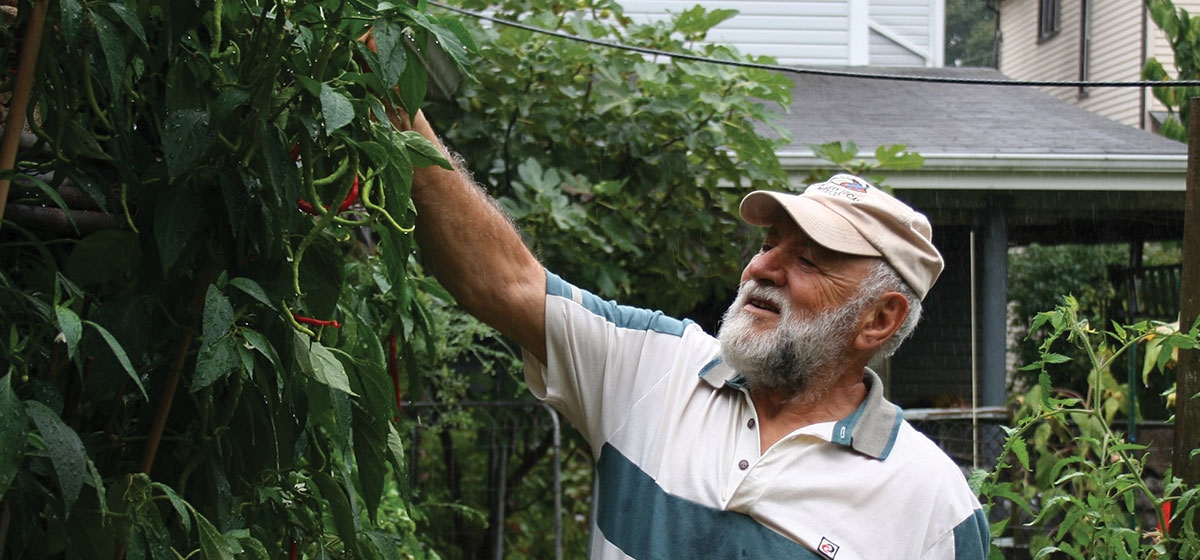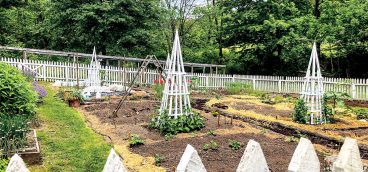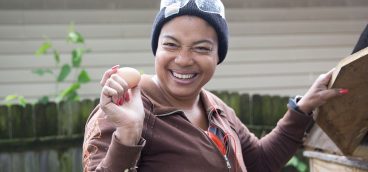The Old Ways May Be Best

Marino floro plucks a perfectly shaped fig from a tree in his Sewickley yard, opens the door to his chicken coop, and offers the fruit to a chamois-colored hen, which clucks with enthusiasm.
Three chickens inhabit this paradise of a mini-farm, where trees yield four different kinds of figs, as well as peaches, plums, apricots, and pears. Pathways inlaid with brick meander past row after row of broccoli, escarole, potatoes, tomatoes, and eggplant.
Floro began cultivating his garden in 1953 when he emigrated from Italy with his 14-year-old bride and packets of seeds from his native Calabrian turf. He also brought the root of a fig tree— a gift from his father-in-law—that became the genesis of his backyard orchard today.
“A garden is like a baby you have to feed and constantly take care of,” says Floro, now 85. “For me, it isn’t work.”
Rather, it is a self-sustaining way of life for Floro and dozens of other immigrants whose earth-to-table traditions are being documented by Mary Menniti, founder of The Italian Garden Project. Inspired by childhood memories of her immigrant grandfather’s garden in New Castle, Menniti began eight years ago to capture an approach to growing and preparing food that she fears is fading from the landscape.
What started with a dozen gardeners in and around Pittsburgh has grown to include dozens more in Ohio, New York, Maryland, Massachusetts and California. “Many of these immigrants are in their 70s, 80s and 90s, and their way of life is dying off,” says Menniti, of the North Hills.
“I want to shine a spotlight on them because they deserve to be recognized, and they have so much to teach us about living more satisfying, less fragmented lives, connected to the earth, our food, and each other.”
Although her hope is that their practices will inspire today’s generation, she admits that even folks in the slow-food movement might find what Floro does with such ease to be too daunting a challenge. “No one is going to do all this,” says Menniti, gesturing toward Floro’s pantry, which is packed with jars of colorful olives, sweet peppers, and tomato sauce, and a freezer filled with bell peppers that Floro picked by the bushel and then roasted.
“I could eat for a year without having to go to the store,” Floro says.
Long before locavore entered the lexicon, he and others in the garden project were living a slow-food life. Peppers sit in his basement, curing in pails of salt-water, an ancient process that takes months and eventually will produce a condiment to be added to scrambled eggs and other dishes. “You have to rinse the salt two, three, even five times,” Floro says. “Then you add a little olive oil and garlic and fry it up.”
Like several of the project gardeners, Floro was raised on a farm, where he learned to appreciate the cycle of living things, and acquired the sort of patience that nature demands. He herded sheep, lived without indoor plumbing or electricity, and ate figs instead of candy. Organic gardening is nothing new to Floro, who eschews chemical sprays, and fertilizes with mushroom manure and an old-school technique that rotates crops of winter wheat.
Fellow Calabrian and project participant Giovanna Palmieri also grew up on a farm.
“You grew things in order to eat,” says Palmieri, 80, who has transformed her small Oakland courtyard into a garden of earthly delights. A passion-flower vine used for brewing tea covers one fence, while fig trees, grape vines and raspberry shrubs thrive in a raised bed against the garage. Crocks abound with herbs, tomatoes and hot peppers.
“I could eat for a year without having to go to the store.”
—Marino Floro, participant, The Italian Garden Project
There’s even an olive tree, whose fruit Palmieri eats raw because she knows precisely when it can be harvested. “You have to wait until the olives get ripe and wrinkly, and then you can eat them. Oh my, are they good!” she says, as she places her hands over her heart.
Palmieri learned as a child to press olives for oil, and to mill the oil for soap. Her family grew flax to weave into linen for their pillow cases and sheets. They also made silk from silk worms that had to be fed fresh mulberry leaves.
“We never went to a grocery store to buy things,” says Palmieri, whose self-sustaining lifestyle is a tribute to her heritage and a love of the land that is in her blood. “To tell you the truth, growing things is all I’ve ever known.”
She, Floro and many others in the project came to America after World War II because Italy’s economy was broken. Typically, a cousin in the States arranged for a sponsor who helped pay their way and then would provide work. “Wealthy people in places like Sewickley Heights wanted to hire people who could be vouched for,” says Menniti. “Italians were a natural fit to care for the grounds of the big estates.”
Floro still works occasionally for a few Sewickley residents with sizeable grounds. His cousin Michele Vaccaro is a full-time landscaper who also participates in The Italian Garden Project. At the project’s Fig Fest! and Terra Buono dinner last August—events designed to showcase the gardeners’ bounty—Floro and Vaccaro demonstrated old-fashioned wine-making, olive-curing, and sausage-curing.
“All Italians love food,” says Vaccaro, 61, who emigrated to Sewickley when he was 21 but maintains the traditions of his youth. “Here is the American way, but in Italy, we have our big meal at 1:30 in the afternoon, with a lot of courses. We take our time. And at night, we eat light because we’re not burning calories.”
Vaccaro still travels to Italy every January to work on his ancestral farm.
Menniti has videotaped several of the properties in her project, one of which now also has a place in the Smithsonian Institution’s Archives of American Gardens. For that collection, the Village Garden Club of Sewickley documented the working garden of Giovanni and Maria Macchione as the 2012 growing season progressed from planting to harvest. Visitors to www.si.edu (enter Archives of American Gardens in the site’s search bar) can view dozens of photographs of the half-acre plot lush with 26 fruit and nut trees, including chestnut and persimmon; crops ranging from raspberries to rapini; and a classic Italian grape arbor.
“Their garden was so beautiful, yet efficient,” recalls Alisa Lenhardt, the garden club member who photographed the Macchione garden for the Smithsonian archives. “What really amazed me is how small it was yet how much they grew in close, perfectly-spaced rows.”
Lenhardt also marveled at the Macchiones’ self-contained system for working the land. “Gardeners spend so much money on seeds, fertilizer, tomato cages—things like that,” Lenhardt says. “The Macchiones harvested seeds in fall to plant in spring, and even grew their own bamboo to make tomato stakes.”
Although they welcomed her visits, the Macchiones were puzzled by the attention, Lenhardt recalls. “For them, keeping a garden was an everyday thing, no more unusual than brushing your teeth.”
A year after the photographs were taken, the Macchiones, now in their 80s, downsized to a smaller home, and the garden they had is all but gone.
It illustrates the importance of Menniti’s effort to document their way of life, says Smithsonian museum specialist Kelly Crawford. “Gardens are cultural landscapes. They’re also very ephemeral. Images fix them in time, so to speak. They let us recreate what gets lost and preserve them for future historians.”
Menniti is cultivating a living legacy of the Italian gardening tradition through a stand of fig trees now growing on private property in Fox Chapel. “We’re using stock from trees that are at least 25 years old, so we can be pretty certain their origins were in Italy,” she says. “We’ve been able to trace some of the trees to particular villages. They were probably smuggled here in the lining of someone’s coat.”
For Menniti, the fig tree is especially symbolic of the immigrants’ will and spirit. “To bring a Mediterranean tree here and make it possible for it to survive an East Coast winter speaks to their knowledge, their love of earth, and their desire for a connection to home. Those trees were grown for more than the fruit, and we don’t want that to get lost.”




